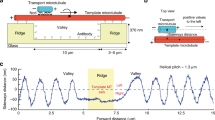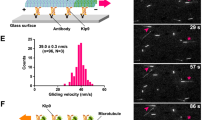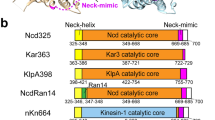Abstract
MITOSIS comprises a complex set of overlapping motile events, many of which involve microtubule-dependent motor enzymes1,2. Here we describe a new member of the kinesin superfamily. The protein was originally identified as a spindle antigen by the CHO1 monoclonal antibody3 and shown to be required for mitotic progression4,5. We have cloned the gene that encodes this antigen and found that its sequence contains a domain with strong sequence similarity to the motor domain of kinesin-like proteins. The product of this gene, expressed in bacteria, can cross-bridge antiparallel microtubules in vitro, and in the presence of Mg–ATP, microtubules slide over one another in a fashion reminiscent of microtubule movements during spindle elongation.
This is a preview of subscription content, access via your institution
Access options
Subscribe to this journal
Receive 51 print issues and online access
$199.00 per year
only $3.90 per issue
Buy this article
- Purchase on Springer Link
- Instant access to full article PDF
Prices may be subject to local taxes which are calculated during checkout
Similar content being viewed by others

References
McIntosh, J. R. & Pfarr, C. M. J. Cell Biol. 115, 577–585 (1991).
Sawin, K. E. & Scholey, J. M. Trends Cell Biol. 1, 122–129 (1991).
Sellitto, C. & Kuriyama, R. J. Cell Biol. 106, 431–439 (1988).
Nislow, C. Sellitto, C., Kuriyama, R. & McIntosh, J. R. J. Cell Biol. 111, 511–522 (1990).
Kuriyama, R. & Nislow, C. BioEssays 14, 81–88 (1992).
Goldstein, L. S. B. Trends Cell Biol. 1, 93–98 (1991).
Endow, S. A. Trends biochem Sci. 16, 221–225 (1991).
Cole, D. G. et al. J. Cell Sci. 101, 291–301 (1992).
Sawin, K. E., Mitchison, T. J. & Wordeman, L. G. J. Cell Sci. 101, 303–313 (1992).
Garnier, J., Osguthorpe, D. J. & Robson, B. J. molec. Biol. 120, 97–120 (1978).
Cohen, C. & Parry, D. A. D. Proteins Struct. Func. Genet. 7, 1–15 (1990).
McLachlan, A. D. & Karn, J. J. molec. Biol. 164, 605–626 (1983).
Yang, J. T., Layman, R. A. & Goldstein, L. S. B. Cell 56, 879–889 (1989).
Roberts, B. Biochim. biophys. Acta 1008, 263–280 (1989).
Jans, D. A., Ackerman, M. J., Bischoff, J. R., Beach, D. H. & Peters, R. J. Cell Biol. 115, 1203–1212 (1991).
Hollenbeck, P. J. J. Cell Biol. 108, 2335–2342 (1989).
Rodionov, V. I., Gyoeva, F. K. & Gelfand, V. I. Proc. natn. Acad. Sci. U.S.A. 8, 4956–4960 (1991).
Pfarr, C. M. et al. Nature 345, 263–265 (1990).
Lombillo, V. A., Coue, M. & McIntosh, J. R. in Methods in Cell Biology. (ed. Scholey, J.) (Academic, Orlando, in the press).
Heidemann, S. R. & McIntosh, J. R. Nature 286, 517–519 (1980).
Cande, W. Z. & Wolniak, S. M. J. Cell Biol. 79, 573–580 (1978).
Cande, W. Z. et al. in Cell Movement Vol. 2 (eds Warner, F. D. & McIntosh, J. R.) 441–452 (Liss, New York, 1989).
Yen, T. J. et al. EMBO J. 10, 1245–1254 (1991).
Saunders, W. S. & Hoyt, A. M. Cell 70, 451–458 (1992).
Roof, D. M., Meluh, P. M. & Rose, M. D. Cold Spring Harb. Symp. quant. Biol. 56, 693–703 (1991).
Hagan, I. & Yanagida, M. Nature 356, 74–76 (1992).
Kozak, M. J. Cell. Biol. 108, 229–241 (1989).
MacDonald, R. J., Swift, G. H., Przybyla, A. E. & Chirgwin, J. M. Meth. Enzym. 152, 219–227 (1987).
Studier, F. W., Rosenberg, A. H., Dunn, J. J. & Debenhoff, J. W. Meth. Enzym. 185, 60–89 (1990).
Lin, K.-H. & Cheng, S.-Y. Biotechniques 11, 748–753 (1991).
Williams, R. C. Jr & Dietrich, H. W. III Biochemistry 18, 2499–2503 (1979).
Yang, J. T., Saxton, W. M., Stewart, R. J., Raff, E. C. & Goldstein, L. S. B. Science 249, 42–47 (1990).
Huang, B., Piperno, G. & Luck, D. J. L. J. biol. Chem. 254, 3091–3099 (1979).
Author information
Authors and Affiliations
Rights and permissions
About this article
Cite this article
Nislow, C., Lombillo, V., Kuriyama, R. et al. A plus-end-directed motor enzyme that moves antiparallel microtubules in vitro localizes to the interzone of mitotic spindles. Nature 359, 543–547 (1992). https://doi.org/10.1038/359543a0
Received:
Accepted:
Issue Date:
DOI: https://doi.org/10.1038/359543a0
This article is cited by
-
Whole Transcriptome Analysis Reveals the Global Molecular Responses of mRNAs, lncRNAs, miRNAs, circRNAs, and Their ceRNA Networks to Salinity Stress in Hong Kong Oysters, Crassostrea hongkongensis
Marine Biotechnology (2023)
-
Kinesin family member 23 knockdown inhibits cell proliferation and epithelial-mesenchymal transition in esophageal carcinoma by inactivating the Wnt/β-catenin pathway
Functional & Integrative Genomics (2023)
-
Identification of potential markers for differentiating epithelial ovarian cancer from ovarian low malignant potential tumors through integrated bioinformatics analysis
Journal of Ovarian Research (2021)
-
KIF5B modulates central spindle organization in late-stage cytokinesis in chondrocytes
Cell & Bioscience (2019)
-
Kinesin-6 Klp9 plays motor-dependent and -independent roles in collaboration with Kinesin-5 Cut7 and the microtubule crosslinker Ase1 in fission yeast
Scientific Reports (2019)
Comments
By submitting a comment you agree to abide by our Terms and Community Guidelines. If you find something abusive or that does not comply with our terms or guidelines please flag it as inappropriate.


